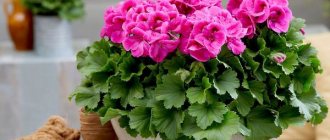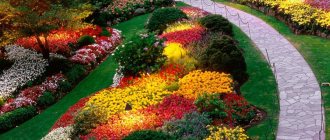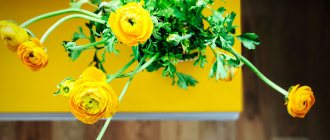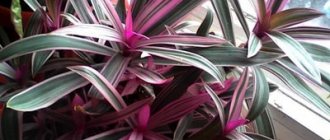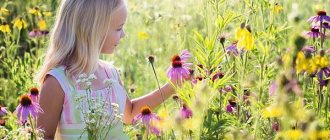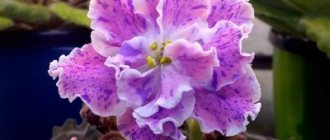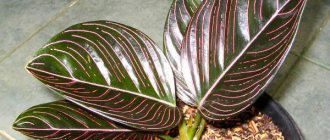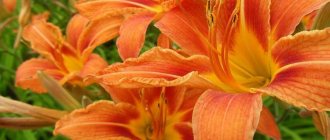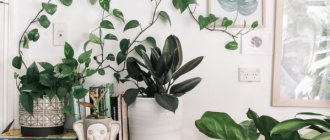Popular variegated indoor plants: photos and names
I grow dozens of plants in my home.
Among them there are tall palm trees, hanging crops, herbaceous and rosette specimens. A special place among all this diversity is occupied by variegated plants. Despite the rarity of flowering, they have a decorative appearance and look unobtrusive in any room. In this article I want to share with you the most interesting types of plants with variegated leaves.
Choosing evergreen variegated shrubs for the garden
The diversity of this group is quite large and there is plenty to choose from. We will describe the most popular varieties of bush plants with variegated foliage.
Fortune's Euonymus (Euonymus fortunei 'Aureo-Variegata')
There are several species with variegated varieties ('Gracillimus', 'Coloratus', etc.). Let's describe the most popular - Fortune's Euonymus variegated (variegated). An evergreen representative of low-growing shrubs.
Creeping variety, up to 0.5 m high. Sometimes used as a vine. The round, dark green leaves of this species have jagged white edges. In autumn and winter, the leaves take on a pink tint. Tiny greenish-white flowers give way to pinkish-red, pea-sized fruits.
English variegated holly (Ilex aquifolium 'Argenteo Marginata')
A medium-sized evergreen subshrub with a conical shape, with spiny, wavy leaves edged in shades of cream and pink.
The flowers are small, dull white, the berries are bright red. Such bushes will unforgettably decorate your garden in winter. In adulthood it reaches 4.5 meters. But it is easy to form a crown, which is why the height of the plant can be reduced by regularly trimming it.
Japanese Privet (Ligustrum japonicum 'Variegatum')
An erect evergreen shrub with glossy evergreen leaves growing profusely on upright spreading branches. Grows up to 3.60 m in height and 4.5 m in width.
The rounded foliage is adorned with creamy white edges and spots. Small creamy white flowers appear in late spring - early summer. The Variegatum variety is often used as an ordinary shrub or in a hedge.
Evergreen Variegated Boxwood (Buxus sempervirens 'Variegata')
Variegated form of the old classic shrub. Variegated Boxwood has attractive green foliage with creamy white edges.
The small shiny oval leaves are very decorative and remain green all winter. Neither flowers nor fruits have decorative value. It requires full sun or partial shade and is tolerant of heat and cold.
Sweet wolfberry (Daphne odora 'Aureomarginata')
An evergreen shrub with shiny, thick green leaves edged with yellow. For planting, choose a place with partial shade.
At maturity, the plant will reach up to 1.5 meters in height and width. Fragrant reddish-purple flowers bloom in late winter until early spring, and red berries herald the arrival of autumn.
Mass planting in groups or in mixed planting is recommended; it can also be used as an independent plant.
Variegated eagles (Eleagnus pungens 'Variegata')
Autumn-blooming evergreen broad-leaved plant with variegated leaf margins. Mature shrubs are approximately 3 meters high and wide.
The 'Maculata' variety has yellow leaves with green edges and a coppery underside, while 'Clemson Variegated' has white leaves with a green edge. The small autumn flowers have a scent often reminiscent of Gardenia.
What is variegation
The botanical term “variegation” literally translated from English means “variegated, spotted.” Used for plants that have variegated leaf blades. Variegated cultures are biological chimeras that have several genotypes in their tissues.
In the tissues of the leaves and stem there are mutated cells that are unable to synthesize chlorophyll. This is what causes light or pink areas to appear. The pattern can be different, the spots form the shape of rings, are located along the veins or along the border.
Variegated plants have become popular for home growing and are valued for their decorative and unusual appearance.
Types and varieties of Tradescantia
There are about one hundred species and varieties of this plant. Let us introduce you to the most common ones.
White-flowered (Albiflora)
This species has long bending shoots that grow up to 50 cm. The leaves are large, ovoid-oval, monochromatic or painted with alternating stripes of white and pale green. The bottom of the leaf is slightly lighter than the top. The edges of the leaf blade are pointed. The surface is glossy. It blooms on the tops of the shoots with small flowers in the form of umbrellas of white or pale pink color.
This may be interesting: Arrowroot - types and varieties of prayer plants
Varieties of white-flowered tradescantia:
Aurea - its yellow leaves are dotted with green stripes
Tricolor - its green leaf plate is decorated with stripes of white, pink and lilac colors
Albovittata - white stripes of different sizes run along the green background of the leaf
Striped or Zebrina
She is one of the most beloved among flower growers; without exaggeration, we can say - a real beauty! It has a strong stem up to 50 cm in height. The leaves are also long, up to 30 cm, their width is 5-6 cm. The color of the leaf below is unusually lilac-violet in color, and the top is covered with silver, purple and white longitudinal stripes. It blooms with purple or violet small flowers.
Blossfeldiana
This type of Tradescantia has dense, dark green, lanceolate-shaped leaves with a sharp tip and are quite large in size. The upper side of the leaf has a rich green color with a soft reddish tint. The lower part of the leaf is dark purple, with soft fibers. The stems of the plant are dense and have a burgundy-green sheath. They are also covered with lint. Three-petalled inflorescences of a delicate lilac color may appear in the axils of the leaves. The stamens and sepals are covered with long silvery fibers.
Scaphoid (Navicularis)
This is the most unusual type of indoor tradescantia. It has decorative creeping stems of a green-violet hue with raised tips and thick small leaves, reminiscent of a boat in shape. The leaves are arranged very tightly among themselves and are closely pressed against the shoots. The color of the leaf blades can be different: green, red or purple.
Riverside or Myrtle-leaved (Fluminensis)
Wild specimens of this type of Tradescantia have even green leaves. The flowers are white, small, with bright yellow stamens.
But, at home you can find plants with striped or even spotted leaves. Its shoots are thin, purple-red in color. The leaves are oval, bright green, small. On the underside they are lilac-violet.
Hairy (Sillamontana)
This is the only type of Tradescantia that can live in dry conditions due to the fact that its stems and leaves are covered with long whitish hairs that help accumulate and retain moisture, protecting the plant from loss of it. The shoots grow vertically, but droop with age.
In the summer, single pink flowers with a lilac tint form on the tops of the shoots of Tradescantia Sillamontana.
The species cannot live in cold conditions, so in winter it must be kept in a warm room.
This may be interesting: Yucca - reproduction, diseases and pests
Virgin (Virginiana)
This species is characterized by straight, branched shoots up to 50-60 cm in length. The leaves are lanceolate, 20 cm long and 4 cm wide. Their base is covered with thin, soft fibers. In mid-summer it blooms with purple or pink flowers that form dense umbrella inflorescences. Flowering lasts about 2 months.
This species can be grown in garden plots as a beautiful flowering perennial, as it is very hardy and tolerates winter well.
Varieties of Virginia Tradescantia differ in different shades of petals:
Rubra
Atrorubra
Caerulea
Rosea
Andersona
This species includes hybrids bred by breeders based on Tradescantia virginiana. They have well-branched straight stems, reaching 80 cm, on which voluminous, slightly elongated leaves grow. Tradescantia blooms all summer long with flowers with flat three petals in blue, white, pink or purple shades.
Its most famous varieties:
Iris – with flowers of intense blue tone
"Osprey" - with snow-white flowers
Purple (Pallida Purpurea)
This species has fairly branched stems of a deep purple hue. The leaf blades are the same purple, their lower part is covered with pile. The flowers are small, three-petaled, delicate crimson or pink. During flowering, its bright purple leaves are made even more beautiful by the large number of light pink flowers.
Small-leaved (Callisia)
This decorative species is cultivated exclusively for indoor cultivation. Its thin brownish-purple shoots are abundantly covered with tiny smooth leaves - dark green on top and purple on the back.
Bedspreada (Spathacea)
This species is distinguished by an erect shoot, around which a strong rosette of lanceolate-shaped leaf plates is formed. The surface of the leaf plate is glossy, green on the front side and pinkish-violet on the back. The flowering period is short. The flowers are small and white. They form under a blanket that looks like a boat. This feature gave the species another name - “Boat of Moses”.
Lodges
This species is native to Australia. It differs from other relatives in that it does not develop long shoots. The leaves are large, olive green in color with a silver stripe in the middle. The shape of the leaves resembles an elongated oval and forms a rosette at the bottom.
Features of variegated plants
Despite their high decorative value, variegated plants are sensitive to maintenance conditions. Features of variegated crops:
- sensitivity to any changes in external factors;
- demands on lighting conditions;
- heat-loving, low resistance to drafts;
- the need for fertilizing;
- maintaining moderately moist soil.
As the plant grows and develops, variegation can change in saturation and disappear completely. Cells get rid of non-chlorophyll areas, as they weaken metabolic processes and disrupt nutrition.
When selecting and propagating domestic crops with variegated leaves, attention is paid to preserving the decorative color, so their variegation is quite stable.
Popular types
In the wild, variegation practically does not occur, since nature tries to get rid of weak individuals. Almost all flowers with variegated leaves for home cultivation were bred by humans. Let's look at 10 of the most interesting variegated plants.
Sansevieria, or Pike Tail
A popular houseplant in the Asparagus family, known for its decorative leaves that can grow over 1 m. Sansevieria is native to Africa and has been cultivated as a houseplant since the 18th century. It is an evergreen perennial with long leaves that grow from tubers.
They are painted in a dark green shade, there are light stripes in the center and along the edges of the leaf plates. Suitable for growing in the office, it is unpretentious. Sansevieria is able to absorb toxins from the environment.
Ficus benjamina
The most famous representative of the Ficus genus. It grows wild in tropical regions of Africa, preferring moist forests and the foothills of mountains. In an apartment, the plant can grow up to 1.5 m and forms strong, erect stems.
The smooth leaves grow up to 12 cm in length and are normally glossy green. Particularly popular are varieties with variegated leaf blades. The plant is demanding on humidity and light. The flower grows quickly, but you should be careful when replanting - the roots of ficus benjamina are fragile and easily damaged.
Stromanta
Perennial ornamental plant of the Marantaceae family. The flower's homeland is the tropics of South and Central America. Distinctive features of stromanta:
- height varies from 80 to 150 m;
- leaves grow up to 50 cm in length;
- depending on the type, the green leaf blades have light spots, white stripes or a red pattern on the back side;
- the plant moves in the direction of the sun, all parts of the flower are directed towards the light source. Because of this, the flower is often called “praying”.
Stromanta is a difficult plant to care for. With insufficient lighting and irregular watering schedules, decorative leaves begin to dry out and curl. To grow, you need to maintain humidity at 85-90%.
Scindapsus
A multi-species genus of the Araceae family. Found naturally in Southeast Asia. Scindapsus is a perennial vine that can grow up to several meters when grown indoors. Translated from Latin, the name of the plant means “devil’s ivy”; all parts of the plant are poisonous to humans and animals.
Forms beautiful heart-shaped leaves of variegated color. Variegation is observed only in flowers from 2 years of age; at a young age, the green color of the vegetative parts predominates. Scindapsus is not able to bloom at home, but thanks to its beautiful decorative leaves it is actively used for interior landscaping.
Hypoestes
Tropical plant of the Acanthus family. Natural habitat - humid regions of Africa, Madagascar. The height of the bush is 30-60 cm, the stems become woody and bare as they develop. Hypoestes is known for its spectacular red-green or almost white leaves; the flowers are rather modest.
Unlike other variegated crops, the flower does not require care. An important condition for growing is maintaining a high level of illumination, otherwise the leaves begin to fade and the stems become elongated.
Which deciduous variegated shrubs are worth paying attention to?
Let us briefly describe the common variegated forms of bush plants that shed their foliage for the winter.
Flowering weigela (Weigela florida 'variegata')
The variegated form of a bush plant decorates the garden landscape with white and pale pink flowers from spring to autumn. But, the distinctive feature of this variety is its green foliage with creamy white edges.
This low-growing plant with a height and width of 30 cm to 50 cm is ideal for sunny locations. Best used in flowerbeds, as a border plant or planted in pots.
Viburnum lantana 'variegata'
A shrub with a spherical crown up to 2 m high, quite branched with a dense crown. Notable for its light and dark green leaves interspersed with golden hues.
Although this variegated variety grows more slowly than its green-leaved relatives, it produces profuse, unfragrant white flowers followed by fruits that vary in color from green to red to black.
Hydrangea macrophylla 'variegata'
A deciduous, rounded shrub with bright green foliage edged with white. The fast-growing bush reaches 2 meters in height and width.
Blooms in early summer with round clusters of small pinkish-white flowers. Ideal for borders, planting as a focal plant or mass plantings, adding a splash of color to shady gardens.
Cotoneaster atropurpureus 'variegatus'
An adult plant reaches one meter in height and width. In spring it produces small, shiny, round, dark green leaves with jagged white edges.
In the fall, they suddenly change color to red and pink, in addition to the bright red berries.
White dogwood 'Elegantissima' (Cornus alba 'Elegantissima')
Deciduous shrub belonging to the Dogwood family. In adulthood, it reaches a height and width of up to 3 meters. Frost-resistant, can be planted in northern regions. In spring, bright gray-green leaves appear with broad, pure white margins.
This variegation remains bright and does not fade in the summer. In autumn, the leaf colors change to gold, apricot and rose-red. When the leaves fall in winter, its bright red stems appear, adding decorative beauty to the winter garden.
Kerria japonica variegata or 'Picta'
Kerria japonica variety Pict is an elegant deciduous, low-growing, widely rounded, slowly growing shrub with very decorative gray-green leaves and a cream-colored edge. It grows up to two meters in height.
The flowers are abundant, yellow, five-petaled, rose-like.
Loves partial shade. It is also worth mentioning another variegated variety of Kerria Albomarginata - with simple flowers and graceful leaves, framed by a white border.
You might be interested
The best perennial bush flowers for the garden: features and selection rules
We use decorative coniferous shrubs in garden landscape design
The best shrubs for hedges
Crotons, cordyline, sansevieria and ficus
Croton (correct name codiaum)
Of course, champion. It can be very different in overall appearance. And this general appearance primarily depends on the size and shape of the leaves. I have two of them. And they are very different. I especially like that their leaves are dense and leathery.
Crotons with different leaves
Cordilina
Cordyline has this feature that worries me a little: its lower leaves gradually lose color and dry out. The upper ones grow to replace them, so the overall balance does not suffer, so to speak. But it turns out that underneath there is more and more bare trunk. Maybe this needs to be managed somehow?
Here's a cordilina
Sansevieria
Popularly known as “mother-in-law’s tongue.” Since it reproduces easily, it is somehow little valued by noble gardeners. She is usually spoken of with disdain. Well, in vain. I have seen excellent compositions when the entire window sill is filled only with these plants of different heights. And nothing else. It looks like a hedge: green and cheerful. I don't have that much space, so she's alone. But I love her.
Description of the flower
Tradescantia belongs to the Commelinaceae family. Typically, these are evergreen perennial herbaceous shrubs that form dense rows along the edges of warm, humid tropical forests.
This flower is a system of several straight or creeping stems, covered with leaves of various shapes and colors - white, green, blue, gray, red and almost purple. Tradescantia leaves are arranged alternately and have different shapes depending on the species: saber-shaped, lanceolate, elliptical or ovoid. Inflorescences form in the axils of the apical leaves.
This may be interesting: Cordilina - tips for caring for a flower at home
The lifespan of a flower is 7-10 years or more, which is a long time for indoor plants. The height of a bush at home can be up to 30 cm, or twice as high. In the wild, shrubs grow up to a meter in height. The growth rate is high, sometimes up to 30 cm per year.
In indoor culture they are usually classified as decorative foliage plants, but some species, or rather their hybrids, bloom beautifully. Tradescantia blooms in summer, from July to August. In indoor floriculture it is often used as an hanging crop.
My arrowroot garden
A separate topic is arrowroot. This is a real variegated one, with a picturesque pattern. But what captivates me most about arrowroot is the following: I love watching the growth of each individual leaf. It happens like this: a tightly twisted tube appears, which over time gradually unfolds into a rather wide sheet!
Future leaf in a tube
The next day the leaf unfurls
And now the leaves are almost unfurled
My arrowroot garden
And here is the arrowroot flower
And this plant is very touchingly trying to claim to be in bloom. Sometimes tiny, inconspicuous flowers appear. They look like a small violet and look very delicate.
And tell me: do these variegated leaves deserve less admiration than the flowering ones?
Variegated indoor plants and changes in their color
All variegated plants belong to variant forms of flora and are formed as a result of exposure to various external factors. Essentially, variegated houseplants are the result of a genetic mutation in response to unfavorable growing conditions. Therefore, when organizing care for them, it is worth considering many factors. The significance of changes in leaf color may be decisive for subsequent correction of care and applied agricultural practices.
Variegated coloring is characteristic mainly of decorative deciduous types of indoor flowers used for decorating interiors. As practice shows, growing these plants in open ground can completely remove their variegation and at the same time the unusual color of the leaf blade will disappear.
Look at the various variegated plants in the photo, which shows the color options for the leaf plates:
Indoor flowers with decorative leaves (names and photos)
Below are a variety of flowers with decorative leaves and excellent aesthetic properties.
There is plenty to choose from for your floral arrangements. Aeonium
with rosettes of fleshy leaves they look very attractive. Depending on the species, leaf rosettes are located directly on the ground (Aeonium tabuliforme) and on a more or less high trunk (Aeonium arboreum, A. canariense, A. haworthii). The color of the leaves and their shape also vary depending on the species and variety.
Look at these flowers with decorative leaves in the photo, which shows the different stages of plant development:
Family. Crassuiaceae (Crassulaceae).
Homeland. Canary Islands, Morocco.
Location. Sunny, a lot of light. The south window is perfect.
Temperature. Tolerates high room temperatures, but not lower than 10 °C.
Air humidity. Doesn't matter.
Substrate. 1/3 of flower soil mixture, loam and sand or perlite.
Watering. Only to maintain constant moisture in the earthen coma. During the rest period there is very little.
Feeding. Apply cactus fertilizer every 2 weeks.
Transfer. Once every 2 years.
Reproduction. Apical or leaf cuttings.
Pests, diseases. Rarely.
Important! Aeonium tabuliforme dies after flowering. Make sure that the leaves do not dry out from lack of moisture, otherwise the plant will die.
Japanese aucuba (golden tree) Aucuba japonica
Only Aucuba japonica is suitable for the room, a shrub up to 2 m in height with oval large leathery leaves, which in Aucuba japonica variety 'Variegata' are distinguished by golden inclusions, in Aucuba japonica 'Crotonifolia' are half green and yellow, and in 'Goldieana' - yellow in middle.
Family. Sogpaseae (Dogonels).
Homeland. Japan, Korea. Location Light.
Temperature. Not higher than 24 °C.
Air humidity. In warm rooms, sensitive to dry air.
Substrate. Flower soil mixture.
Watering. Abundant.
Feeding. Every 4 weeks. During cool winters, do not fertilize.
Transfer. If necessary, adult plants are rare.
Reproduction. Apical cuttings in spring.
Pests, diseases. Scale insects.
Important! In summer, place outdoors in partial shade. If the plant has become too large, it can be transplanted into a tub
Carefully! Eating berries can cause fever and vomiting
Look at these flowers with decorative leaves in the photo and the name will be completely justified, since it is given by appearance:
Carefully! Eating berries can cause fever and vomiting. Look at these flowers with decorative leaves in the photo and the name will become completely justified, since it is given by appearance:. Look at these flowers with decorative leaves in the photo and the name will be completely justified, since it is given by appearance:
Look at these flowers with decorative leaves in the photo and the name will be completely justified, since it is given by appearance:
Ceropegia
On thread-thin shoots up to 2 m long, small fleshy leaves are formed at significant intervals, with silvery spots on the upper side and red spots on the lower side. Flowers appear from the leaf axils in autumn.
In specimens of the most common type of Wood's ceropegia (Ceropegia woodii), and there are over 150 species in total, aerial tubers are formed on the shoots, which are used for propagation. Ceropegia is an excellent hanging plant.
Family. Asclepiadaceae (Lastovnevye).
Homeland. Africa, Asia.
Location. Sunlight, but not direct midday rays.
Temperature. Room, not lower than 8 °C.
Air humidity. Not significant.
Substrate. Flower soil mixture with 1/3 sand.
Watering. The substrate should be constantly moist in summer and dry in winter.
Feeding. During the growth period every 4 weeks.
Transfer. Once every 2 years.
Reproduction. Nodules or shoot cuttings.
Pests, diseases. Rarely.
Look at these indoor flowers with decorative leaves in the photo, where all the described botanical characteristics are attached:
Colors and shapes of leaves in variegated plants (with photo)
Typically, the color of leaves on plants represents various shades of green, as well as variegated combinations of green with white and other colors. A plant leaf is called variegated, in some areas of which there is an insufficient amount of chlorophyll or no chlorophyll at all. Most often, the most interesting variegation is the result of the work of breeders, who get more and more new patterns and color combinations. The color and shape of the leaves are not interrelated. So, a long leaf can be both green and striped. The heart-shaped leaf can also have different color options.
Pink-variegated species include, for example:
Caladium
Cordyline
Cryptanthus
Hypoestes
The following species are considered red-variegated:
Bloom's Coleus (Coleus blumei, hybrids)
Irezina
Maranta
Tradescantia zebrine
White, cream or yellow variegation is present in some species:
Aglaonema
Chlorophytum sotosum
Euonymus (Eonymus)
Pisonia
The leaves of such species as:
Calathea
Stromanta
Their leaf blade shape depends on the period of plant growth.
Croton (Codiaeum) has a very special pattern in green, yellow and orange-red tones .
Many variegated leaves also differ in certain shapes and patterns:
In some, the edge of the leaf is outlined by a strip of a different color, as in Sansevieria trifasciata.
or Dracaena marginata
Other cultures have a marble pattern, for example:
Scindapsus (Epipremnum)
Hypoestes
The leaves of one type of begonia - Begonia masoniana - are decorated with a black cross.
Look at the various variegated indoor plants in the photo, which shows a variety of colors:
Hypoestes
Hypoestes is noticeably different from other indoor plants by the presence of pink spots on the leaves. But if you do not provide the flower with the necessary amount of light, the spots will disappear, and the unique plant will become just another nondescript flower on the windowsill. Hypoestes goes well with ferns and other moisture-loving decorative foliage plants.
Caring for hypoestes is a real creative work, since the plant needs certain conditions. It is recommended to take the pot out into the fresh air in the summer, but the plant should be protected from drafts. The optimal air temperature is 17-18°C.
The color of the leaves directly depends on the lighting - it should be bright, but with a small amount of direct sunlight. The soil should be constantly moderately moist. For frequent watering, use soft water at room temperature.
How not to lose the variegation of indoor plants
In our homes you can often find plants with colorful leaves. All kinds of fancy patterns and designs, spots, specks, dots, borders, stripes and strokes - all this attracts our attention. It often happens that a variegated plant overshadows the beautifully flowering ones, because their flowering period is not long, and the variegated plant constantly decorates our house with its leaves. Naturally, such plants are preferred and they are the first to disappear from the shelves of flower shops.
Among the variegated ones, the well-known and familiar to us are chlorophytums, caladiums, tradescantia and begonias, ficuses, and many indoor vines (epipremnum, monstera, syngonium, scindapsus). The most popular variegated plants are crotons, coleus and royal begonias, ivies and dracaenas, dieffenbachias and cordylines. Many people are familiar with multi-colored fittonias, euonymuses and sansevierias. Some of the most spectacular and intricate variegates were representatives of the arrowroot family - stromantha, calathea, arrowroot.
When purchasing such variegated plants, you need to remember that they are more demanding and capricious compared to plants with regular colors. In addition to the general species rules, there are certain features for caring for such plants.
First of all, these are the requirements for room illumination . Variegated varieties always prefer an abundance of diffused daylight. Some of their cells are mutated and cannot participate in the process of photosynthesis in whole or in part. This mutation is not stable, and if you place such plants in partial shade, they will happily try to get rid of their “disease” and will eventually turn into their usual green form.
Plants with colored leaves grow quite slowly compared to ordinary “green” ones, so there are certain requirements for the soil . Heavy soil is not suitable for them; the soil must be light and breathable, but at the same time it must retain the required amount of moisture. An example of the composition of a suitable soil mixture could be as follows: 5-6 parts of turf soil, 2 parts of leaf humus, 2 parts of peat, 1 part of sand. The acidity of the soil should be neutral, within pH=6-7.
be fed , like all others, during the period of active growth once every 2-3 weeks with full mineral fertilizers. It is better to refrain from organic fertilizers. Particular attention should be paid to not overfeeding the plant with nitrogen, so that they do not lose their main decoration - variegation.
It happens that a completely green sprout suddenly begins to grow on a variegated variety; it must be removed without regret. Don't give your plant a chance to revert to its green leaf form.
With the help of a variegated plant, even a small one, you can advantageously emphasize and draw attention to the necessary details of the interior. You can create unique compositions by placing a variegated plant in a group with a flower blooming to match it. You can advantageously shade and emphasize variegation with a contrasting combination of colors.
By choosing variegated variegated varieties to decorate your home, you are choosing a win-win option. By following the recommendations for caring for individual species in particular and knowing the characteristics of variegated plants in general, you can create a unique flavor for your home. Saturated bright or calmer color combinations will delight you all year round.
Caring for indoor Fittonia flower at home
Remember that the temperature should not fall below +18 degrees, otherwise Fittonia will begin to shed its leaves
If you follow the recommendations of specialists, caring for Fittonia at home is not particularly difficult. Due to its decorative qualities and relative unpretentiousness, this plant is very popular among gardeners.
Optimal temperature
Fittonia is a heat-loving plant, so the optimal air temperature for growing in summer should be no lower than 22 - 25 degrees, in winter - within 20 . If the temperature is below 18 degrees, Fittonia sheds its leaves. This indoor plant does not tolerate drafts or sudden changes in air temperature. Therefore, it is not recommended to take Fittonia out onto the balcony even in summer. In winter, the plant should not be placed near heating devices.
Lighting for Fittonia
Like many indoor plants, Fittonia loves bright rooms. It is not recommended to place the plant on sunny windows on the south side. Fittonia may die if exposed to direct sunlight. It is best placed on eastern and western window sills. The plant tolerates light shade well. In winter, in case of lack of lighting, Fittonia leaves lose their beautiful color. Therefore, in winter, it is recommended to increase the daylight hours for the plant using special lamps.
An amazing indoor plant, passionflower, which not only blooms beautifully but also produces edible fruits.
If you like unusual indoor flowers, be sure to take a look at the variegated stapelia plant.
Air humidity
Fitonia is not only a heat-loving plant, but it also loves high humidity.
When caring for Fittonia, you should remember that it loves high air humidity. It is advisable to spray the plant throughout the year, using settled or filtered water. If the indoor air is dry, it is recommended to spray Fittonia twice a day. To increase humidity, a pot with an indoor flower can be placed on a tray with expanded clay or pebbles. It is strictly forbidden to use leaf polishing agents .
Watering Fittonia
From the beginning of spring until autumn, Fittonia needs to be watered abundantly and regularly with warm, settled water. In late autumn and winter, watering is gradually reduced. However, the earth ball should not be allowed to become dry, since even if the root part dries out once, the leaves of Fittonia fall off. The plant intensively evaporates water from its leaves, as a result of which moisture from the soil evaporates very quickly. The soil in the pot should always be slightly moist, but water stagnation should not be allowed, since excessive moisture leads to rotting of the plant's root system.
Soil composition and fertilizers
The soil for Fittonia to grow should consist of a mixture of humus soil, peat and sand. Considering that the root system of the plant is superficial, it is recommended to use shallow but wide pots and containers, with drainage installed at the bottom.
From April to September, during the active growing season of Fittonia, it must be regularly fed with mineral fertilizers. However, since the plant is very sensitive to excess fertilizer, their concentration must be halved from the usual dose indicated on the package.
Rejuvenation
Every year in the spring, Fittonia must be replanted
Approximately every three to four years, Fittonia needs to be rejuvenated. This is determined as the lower part of the shoots becomes exposed. To rejuvenate the plants, the most elongated branches are cut off, which are rooted in the ground under glass. Rejuvenation is also carried out by splitting off the upper shoots of the plant and rooting them. After this, after some time, Fittonia throws out new side shoots.
Replanting a houseplant Fittonia
Fittonia grows very quickly, so in the spring it needs to be transplanted into a larger pot or container. It is recommended to replant young plants annually.
How to propagate Fittonia
Fittonia is propagated by apical cuttings. Cuttings from shoots are planted in moist soil, regularly sprayed and watered. After rooting the cuttings, they are transplanted to a permanent place in the soil, which consists of a mixture of earth, peat, humus and sand. The plant is also propagated by dividing the bush during transplantation or by seeds. In spring, the seeds are planted in a container with soil, which is constantly kept moist at a temperature of at least 22 degrees.
[adsp-pro-5]
